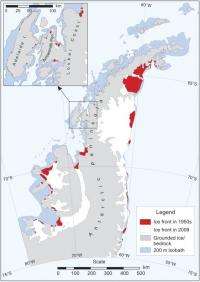Antarctica glacier retreat creates new carbon dioxide store

Large blooms of tiny marine plants called phytoplankton are flourishing in areas of open water left exposed by the recent and rapid melting of ice shelves and glaciers around the Antarctic Peninsula. This remarkable colonisation is having a beneficial impact on climate change. As the blooms die back phytoplankton sinks to the sea-bed where it can store carbon for thousands or millions of years.
Reporting this week in the journal Global Change Biology, scientists from British Antarctic Survey (BAS) estimate that this new natural 'sink' is taking an estimated 3.5 million tonnes* of carbon from the ocean and atmosphere each year.
Lead author, Professor Lloyd Peck from BAS says, "Although this is a small amount of carbon compared to global emissions of greenhouse gases in the atmosphere it is nevertheless an important discovery. It shows nature's ability to thrive in the face of adversity. We need to factor this natural carbon-absorption into our calculations and models to predict future climate change. So far we don't know if we will see more events like this around the rest of Antarctica's coast but it's something we'll be keeping a close eye on."
Professor Peck and his colleagues compared records of coastal glacial retreat with records of the amount of chlorophyll (green plant pigment essential for photosynthesis) in the ocean. They found that over the past 50 years, melting ice has opened up at least 24,000 km2 of new open water (an area similar to the size of Wales) - and this has been colonised by carbon-absorbing phytoplankton. According to the authors this new bloom is the second largest factor acting against climate change so far discovered on Earth (the largest is new forest growth on land in the Arctic).
Professor Peck continues, "Elsewhere in the world human activity is undermining the ability of oceans and marine ecosystems to capture and store carbon. At present, there is little change in ice shelves and coastal glaciers away from the Antarctic Peninsula, but if more Antarctic ice is lost as a result of climate change then these new blooms have the potential to be a significant biological sink for carbon."
More information: Negative feedback in the cold: ice retreat produces new carbon sinks in Antarctica by Lloyd S. Peck, David K. A. Barnes, Alison J Cook, Andrew H Fleming and Andrew Clarke is published online this month in the journal Global Change Biology.
Source: British Antarctic Survey (news : web)














